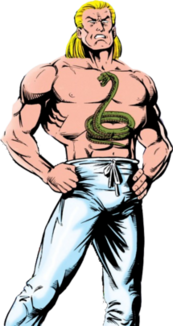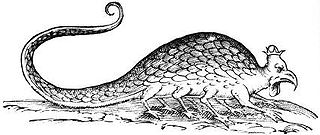
A dragon is a large, serpentine, legendary creature that appears in the folklore of many cultures worldwide. Beliefs about dragons vary considerably through regions, but dragons in western cultures since the High Middle Ages have often been depicted as winged, horned, four-legged, and capable of breathing fire. Dragons in eastern cultures are usually depicted as wingless, four-legged, serpentine creatures with above-average intelligence.

Ragnar Lothbrok or Lodbrok was a legendary Viking hero, as well as a legendary Danish and Swedish king. He is known from Old Norse poetry of the Viking Age, Icelandic sagas, and near-contemporary chronicles. According to the traditional literature, Ragnar distinguished himself by conducting many raids against the British Isles and the Holy Roman Empire during the 9th century. He also appears in Norse legends, and according to the legendary sagas Ragnarssona þáttr and Sögubrot af nokkrum fornkonungum, Ragnar Lodbrok's father was the legendary king of the Swedes, Sigurd Ring.

The serpent, or snake, is one of the oldest and most widespread mythological symbols. The word is derived from Latin serpens, a crawling animal or snake. Snakes have been associated with some of the oldest rituals known to mankind and represent dual expression of good and evil.

King Snake is a fictional character who appears in books published by DC Comics and who is a part of the DC universe, usually as an adversary of Robin and Batman. Created by writer Chuck Dixon and artist Tom Lyle, King Snake first appeared in Robin #2 (1991). He is a master martial artist and is the father of the villain Bane.

Gundaharius or Gundahar, better known by his legendary names Gunther or Gunnar, was a historical king of Burgundy in the early 5th century. Gundahar is attested as ruling his people shortly after they crossed the Rhine into Roman Gaul. He was involved in the campaigns of the failed Roman usurper Jovinus before the latter's defeat, after which he was settled on the left bank of the Rhine as a Roman ally. In 436, Gundahar launched an attack from his kingdom on the Roman province of Belgica Prima. He was defeated by the Roman general Flavius Aetius, who destroyed Gundahar's kingdom with the help of Hunnish mercenaries the following year, resulting in Gundahar's death.

Sigurd Snake-in-the-eye or Sigurd Áslaugsson was a semi-legendary Viking warrior and Danish king active from the mid to late 9th century. According to multiple Saga sources and Scandinavian histories from the 12th century and later, he is one of the sons of the legendary Viking Ragnar Lodbrok and Áslaug. His historical prototype might have been the Danish King Sigfred who ruled briefly in the 870s. Norwegian king's genealogies of the Middle Ages names him as an ancestor of Harald Fairhair and used his mother's supposed ancestry the Völsung to create an ancestry between Harald and his descendants and Odin.

Aurelian Smith Jr., better known by the ring name Jake "The Snake" Roberts, is an American professional wrestler and actor currently signed to All Elite Wrestling (AEW) where he performs as manager to Lance Archer. He is best known for his two stints in the World Wrestling Federation ; the first between 1986 and 1992, and the second between 1996 and 1997. He wrestled in the National Wrestling Alliance in 1983, World Championship Wrestling in 1992, and the Mexico-based Asistencia Asesoría y Administración between 1993 and 1994 and again in 1997. He appeared in Extreme Championship Wrestling during the summer of 1997 and made appearances for Total Nonstop Action Wrestling from 2006 through 2008.

Ophiophagy is a specialized form of feeding or alimentary behavior of animals which hunt and eat snakes. There are ophiophagous mammals, birds, lizards, and even other snakes, such as the Central and South American mussuranas and the North American common kingsnake. The genus of the venomous king cobra is named for this habit.

The Investiture of the Gods or The Creation of the Gods, also known by its Chinese names Fengshen Yanyi and Fengshen Bang (封神榜), is a 16th-century Chinese novel and one of the major vernacular Chinese works in the gods-and-demons (shenmo) genre written during the Ming dynasty (1368–1644). Consisting of 100 chapters, it was first published in book form between 1567 and 1619. Another source claims it was published in 1605. Yet another indicates it was published ca. 1625 The work combines elements of history, folklore, mythology, legends and fantasy.

A ball pit is a padded box or pool filled with small colorful hollow plastic balls generally no larger than 3 inches (7.6 cm) in diameter. They are typically marketed as recreation and exercise for children.

The Black Tortoise, known in Chinese as Xuanwu, is one of the Four Symbols of the Chinese constellations. Despite its English name, it is usually depicted as a tortoise entwined together with a snake. Furthermore, in East Asian mythology it is not called after either animal, but is instead known as the "Black Warrior" under various local pronunciations. It is known as Xuanwu in Chinese. It represents the north and the winter season, thus it is sometimes called Black Tortoise of the North.

Naga Panchami is a day of traditional worship of Nagas or snakes observed by Hindus, Jains, and Buddhists throughout India, Nepal, and other countries where Hindu, Jain, and Buddhist adherents live. The worship is offered on the fifth day of bright half of lunar month of Shravana (July/August), according to the Hindu calendar. Some Indian states, such as Karnataka, Rajasthan and Gujarat, celebrate Naga Panchami on the dark half of the same month. As part of the festivities, a Naga or serpent deity made of silver, stone, wood, or a painting of snakes is given a reverential bath with milk and their blessings are sought for the welfare of the family. Live snakes, especially cobras, are also worshipped on this day, especially with offerings of milk and generally with the assistance of a snake charmer.

The Parassinkkadavu Snake Park is located in Anthoor Municipality about 16 kilometres (9.9 mi) from Kannur Corporation in the Kannur district of north Kerala, in south India. The Snake Park is in Parassinikkadavu, which is 2 kilometres (1.2 mi) from National Highway (NH) 17, en route from Kannur to Taliparamba.
Janamejaya was a Kuru king who reigned during the Middle Vedic period. Along with his father and predecessor Parikshit, he played a decisive role in the consolidation of the Kuru state, the arrangement of Vedic hymns into collections, and the development of the orthodox srauta ritual, transforming the Kuru realm into the dominant political and cultural part of northern India. He also appears as a figure in later legends and traditions, the Mahabharata and the Puranas.

TheTale of Ragnar's sons is an Old Norse story about Ragnar Lodbrok and his sons.

Arulmigu Subramaniya Swamy Temple is a Hindu temple, on the hill of Thiruttani, Tiruvallur district, Tamil Nadu, India, dedicated to Lord Muruga. The hill has 365 steps indicating 365 days of the year. It is fifth among the six abodes of Lord Muruga The other five are Palani Murugan Temple, Swamimalai Murugan Temple, Thiruchendur Murugan Temple, Thiruparankundram and Pazhamudircholai Murugan Temple. Thiruttani is 87 kilometres (54 mi) from Chennai. Earlier Thiruttani was called as Thiruveragam,After correct Demon Tharagan (Soorasamharam) he got subsided his angry so here Kandha sasti festival (Soorasamharam) is not conducted.
Jiao Ge was an official of Shang dynasty.

The Thiruvananthapuram Zoo is located in the city of Thiruvananthapuram, the capital of Kerala, India. It occupies 55 acres (22 ha) of woodland, lakes, and lawns.

In European bestiaries and legends, a basilisk is a legendary reptile reputed to be a serpent king, who can cause death with a single glance. According to the Naturalis Historia of Pliny the Elder, the basilisk of Cyrene is a small snake, "being not more than twelve fingers in length", that is so venomous, it leaves a wide trail of deadly venom in its wake, and its gaze is likewise lethal.

A sampy is an amulet or idol of spiritual and political importance among numerous ethnic groups in Madagascar. Amulets and idols fashioned from assorted natural materials have occupied an important place among many Malagasy communities for centuries. Ody, personal amulets believed to protect or allocate powers to the wearer, were commonplace objects possessed by anyone from slave children to kings. The name sampy was given to those amulets that, while physically indistinguishable from ody, were distinct in that their powers extended over an entire community. The sampy were often personified - complete with a distinct personality - and offered their own house with keepers dedicated to their service.


















